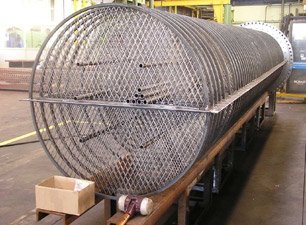EMbaffle Technology
Heat exchangers – a brief background
Shell and tube heat exchangers are ubiquitous in industry for cooling and heating applications. They contain structures known as baffles to support the tubes and guide fluid flow.
In recent years a new type of tube support baffle has been developed, offering major performance improvements over the conventional segmented baffle design and more recent technologies as the design of choice for shell and tube heat exchangers.
EMbaffle® heat exchanger technology represents a step change within tube support baffle design, offering significant performance benefits when compared to conventional designs.
Changing the shape of baffle design
The company has pioneered a step change in baffle design that significantly reduces fouling and eliminates vibration. The design features an expanded metal (EM) baffle grid made of plate material that has been slit and expanded.
The result is a major improvement in heat exchanger performance leading to reduced operating costs, energy consumption and CO2/NOx emissions.
Improving heat transfer
The open flow structure of the baffle allows the shell side fluid to flow along the tubes, but in the vicinity of the baffles the flow area is constricted, creating local turbulence and velocity increase in the flow while breaking up the boundary layer over the tubes. The unique grid shape induces a local cross flow component on top of the longitudinal bulk flow pattern which, together with the localised turbulent flow, improves the heat transfer characteristics at the surface of the tubes.
The break up of the boundary layer occurs repeatedly at each expanded metal baffle along the length of the heat exchanger, resulting in lower hydraulic resistance while maintaining heat transfer. Pressure loss is effectively converted into improved heat transfer and, compared with the segmental baffle, heat transfer at the same fluid velocity is significantly higher.
Reducing shell-side fouling
Stagnant or 'dead zones' found in traditional segmental baffle heat exchangers, which tend to foul rapidly, are not present in EMbaffle® heat exchangers. This results in increased operational running times for production units. Maintenance, cleaning and refurbishment schedules may then be extended, heat recovery improved and firing of furnaces reduced to help reduce CO2 emissions.
Eliminating tube vibration
Because the longitudinal flow on the shell side tube vibration in the EMbaffle® heat exchanger is effectively eliminated, the risk of mechanical damage is significantly reduced. This absence of cross-flow induced vibration allows considerable flexibility in heat exchanger design. For example, if an application demands a low pressure loss, the baffle spacing can simply be increased without the risk of introducing tube vibration.
